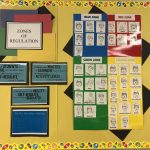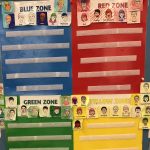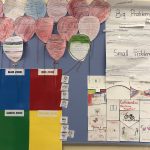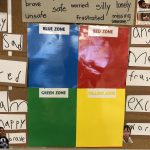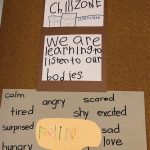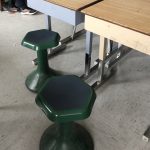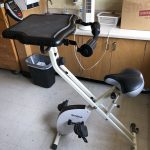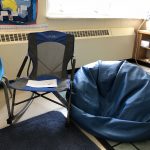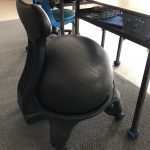You may have heard the phrase before, “All behaviour is a form of communication.” But have you ever considered that 60% of the communication that people do is done non-verbally? That means that 60% of the time, we rely upon physical behaviours to express what we are thinking or feeling.
At Queenston Drive Public School, we wanted to develop and support our students with the tools and strategies necessary to become emotionally self-aware. We feel that understanding our emotions is the first step towards developing one’s self-regulation, self-advocacy and resiliency skills. We also know that by becoming emotionally self-aware, a ripple effect of awareness for others and their needs occurs, which helps to nurture and strengthen positive classroom climate.
We also wanted to encourage, support and provide capacity building for our school staff so that they too could develop and support their own levels of self-awareness and emotional health skills. By providing our staff with authentic and useful professional learning opportunities, applicable strategies, concrete learning tools, self-regulation furniture supports and print resources, we felt that our staff would feel armed and ready to support the emotional needs of their students.
And lastly, we wanted to involve our school community by keeping them informed and engaged in our learning, and encourage them to engage in some learning of their own as a family.
Our action plan began with a very formal title and has evolved into what we now affectionally call, “The Well-Being Project!”
Team Members
Erica Glover, OCT
Peel District School Board
Carrie Smith, OCT
Peel District School Board
Cheryl Mitchell, OCT
Peel District School Board
Raffaella Cameriere-Preston, OCT
Peel District School Board
Professional Learning Goals
- Built capacity with staff throughout the school, using common emotional health and self-regulation language, knowledge and strategies to link all school success teams
- Built knowledge and awareness with our students around the importance of positive emotional heath and how they can develop greater self-awareness and self-advocacy skills
- Supported the needs of our school community by supporting and helping parents understand the role the stress can play in their children and our students, and what they can do to help support their children through times of stress
Activities and Resources
- Explored and utilized the work of Stuart Shanker
- Linked learning to the “Supporting Minds” document
- Provided multiple Professional Learning opportunities for staff (“Lunch & Learn” formats) around the “Zones of Regulation” program, use of “Chill Zones” & Fidgets, and understanding the use of behaviour as a form of communication
- Collaborative support teachers facilitated ongoing discussions and activities with students in classrooms around the idea of stress, self-regulation and self-advocacy. Co-teaching between teachers was encouraged to support the development of both students and staff.
- Teachers have begun to implement the “Zones of Regulation” program in their classrooms and are using this program to meet the individual needs of their students. Updates around successes and frustrations with this program have been encouraged and supported.
- Parents were invited to attend a “Mindful Parenting Night” facilitated by Dr. Carly Shecter, C.Psych. We had a turnout of around 24 parents who attended this workshop and the feedback was quite positive!
- Ongoing communication around supporting the emotional health of our students/children was posted and sent out to our school community via ClassDojo, Twitter and in our monthly newsletters.
- The development of a “Mindful Culture” has begun to take hold in many classes through the use of cultivating mindfulness activities, meditation and discussions. The school even participated in a one-minute meditation as part of our Education Week Assembly!
- Opportunities for positive student engagement in extracurriuclar activities has been developed and we are trying our best to develop consistency. Students have a variety of activities that they can participate in like: Weight Lifting Club, ECO Club, Change Now Committee, Office Helpers, Floor Hockey and a variety of other sports teams.
Unexpected Challenges
Establishing our Budget and Cashing the Cheque from OTF. Our school board will not help with this in any way – in fact they have created a policy that strictly forbids them to be involved with this money in any capacity. This was extremely frustrating and stressful for us; the complete opposite of what our proposal stands for!
Teacher Time and Support! Our project had so much valuable teaching that we wanted to share with staff. But without having “release time,” we were always asking teachers to give up their lunch hours. If we were able to get half-day coverages, so much more learning could have happened and I think we would see greater results in our classrooms and with our staff. As organizers of this project, we also found that our own time was very limited and we often wished that we had more time to meet as a group and explore new learning opportunities and programs that we could use ourselves as well as share as part of the project.
Mindsets and Use of the Assigned Materials. While we acknowledge that most of our involved teachers were under their own learning curves and needed time to develop their own levels of understanding and mindsets, it was frustrating at times to see assigned materials, (like “Chill Zone” chairs or Fidgets), not being accessible to students as a self-regulation support. A good portion of our project was the exploration of what works and what doesn’t work. By not having consistent access to our materials, we felt that some of the students were missing out on this crucial exploration component.
Enhancing Student Learning and Development
The “Zones of Regulation” program has been successful in giving both students and staff a common language when identifying and supporting emotion-based behaviour. It is allowing students to clearly communicate their feelings, especially during stressful times, in a non-verbal fashion manner that supports their needs in the moment. For example, by not having to verbally identify that one is feeling angry, upset, sad or depressed, we are finding that students are actually becoming more comfortable with the idea of identifying these emotions that they may have felt they needed to hide from both their teachers or peers. This program is helping to reduce the stigma that talking about one’s feelings, especially the hard ones, is just not what we do.
The self-regulation supporting furniture and tools have allowed students to have access to immediate tools within their classrooms to support their needs in the moment. For example, our Grade 8 classes each have a built-in desktop exercise bike that students can access at any given time. Through dialogues with these students, it became clear that this bike served many different functions – as an energy release, as an energy encourager and simply as a quick break (so no longer does the student have to leave the classroom to walk the hall!). By giving ALL students in classrooms access to self-regulation supporting tools, we are reducing the stigma that is often attached to the use of such tools like Hand Fidgets or alternative seating. So often, the “identified” student, who needs consistent access to these materials, doesn’t want to do so for fear of being labelled as “different” by their peers. And on the flip side, those students who are not “formally identified,” can too have access to these tools. EVERYONE has self-regulation needs and so it just makes sense to provide consistent access to supports and tools that we know work!
Creating dialogue and changing mindsets around emotional health has been an exciting success story from our project. It is amazing to hear students talk about their emotions so openly and share how they are learning to support themselves. So many students have shared with us, especially at the intermediate level, how the use of meditation and mindfulness-promoting activities, like colouring, listening to music or just sitting still, have become “go-to” strategies during times of stress, upset or unbalance. This is amazing!
Sharing
Our main source of sharing with our school community has been through “Well-Being Project” updates in our school newsletter that goes home once a month. During this time, we dialogue with involved staff getting testimonials from teachers and students which are shared. Whenever possible we have also been sharing photos of the activities and supports that classrooms and students are using.
Since a good portion of our classes are connected via ClassDojo, we have found that highlighting and showcasing special events, activities and key learning ideas and sharing out in a visual format to parents has been a positive way to communicate the great work that we are engaged in. We have been posting to our school account on Twitter too, but there are not too many parents connected to the school in this way.
We also had the opportunity to share with our superintendent the premise of our “Well-Being Project” and to show him the amazing things that are happening in our classrooms and school climate as a whole. He expressed support for our efforts and even purchased an additional Stuart Shanker book for the team!
We have also been trying to infuse our “Well-Being Project” in small amounts into our monthly assemblies. Whenever possible, we have been giving updates and sharing success stories. Just recently, during our education week assembly, we also did a school-wide, collective one-minute meditation with great success! This is definitely something that we would like to continue.
Project Evaluation
We first introduced our “Well-Being Project” by sharing our proposal and inviting interested teachers to attend an introduction “Lunch & Learn” around the idea that “All Behaviour is a Form of Communication.” At the end of this time, we shared our project ideas and invited interested teachers to join up and take part in the project. We made it clear that there would be an expected level of commitment and learning from involved staff and that all supporting materials, such as books, differentiated furniture, Fidgets, etc., would be collected at the end of the school year and redistributed in June 2019. In hindsight, we do wish that this initial introduction had been done to ALL staff, perhaps during a staff meeting, as some people who did not initially sign up have expressed an interest in becoming involved and said that they did not fully understand what they were missing out on. As we would love our project to be implemented school-wide, of course we do not want anyone feeling excluded.
Involved classes completed an initial survey that used a rating school of “True, Somewhat True, Very True” and asked students and staff questions like:
“I feel like I belong at this school.”
“I feel safe at this school.”
“My teachers care about me.”
“We learn about making friends and managing our emotions.”
“If I have a problem I can talk to my teacher.”
“Our school can make a real difference towards improving students’ mental health and well-being.”
“Supporting students’ mental health and well-being helps reduce behavioural problems and improves their academic learning outcomes.”
“I feel valued and respected at our school.”
Once we collected these surveys we did have plans to analyze them and use them to drive our project. However, we have found that this has not really happened. Instead, we have been using immediate student behaviour and needs in our classrooms to drive our levels of learning and support. While this authentic “data” is good, we do feel that we have not completed the level of documentation that we initially planned, and this is an area that would need improving during the 2018/2019 school year.
We believe that it is the dialogues and daily use of self-regulation supports like “The Zones of Regulation” program that are giving us our true data!
“The exercise bike really helps me focus on my work and not fool around.”
“Whenever I feel energetic, I use the bike so I can focus much better in class.”
“The bike is very useful as when I feel sleepy or lazy, it gives me a boost up and makes me active.”
Ms. Lawrence, a Grade 4 teacher, says, “My students have even brought the language of the zones into their homes by making references to with their parents. This is a great starting point!”
Ms. Gordon, a Grade 4/5 teacher, shared that “The Zones of Regulation” has been a positive addition to the overall climate of her classroom, and the emotional health of her students. She says that it is now quite common for students to identify how they are feeling by grabbing their name card and placing it in the appropriate zone. From there, they often try to self-regulate or seek support from her or their classmates.
Having students stop us in the hall and share anecdotal stories about how they were feeling stressed and used strategies that we’ve taught them like “Belly Breathing” or a “Pebble Meditation” to calm down is truly powerful feedback. In fact it is so rewarding that it is motivating us to continue our “The Well-Being Project” and hopefully get it implemented in ALL classrooms and with all staff in the school!
Resources Used
“The MEHRIT Centre (TMC) is an educational organization, established by Dr. Stuart Shanker (D.Phil.) in 2012 to work towards a vision of calm, alert children, youth and adults flourishing in physically and emotionally nurturing environments. Our mission is to ground learning and living in self-regulation. Decades of research have shown that self-regulation is the foundation of healthy human development; adaptive coping skills; positive parenting; learning; safe and caring schools; and vibrant communities. TMC works to translate this knowledge into practices that will benefit all children, parents, teachers and leaders in schools and communities.”
“Recent research tells us that one of the keys to student success is self-regulation – the ability to monitor and modify emotions, to focus or shift attention, to control impulses, to tolerate frustration or delay gratification. But can a child’s ability to self-regulate be improved?
Canada’s leading expert on self-regulation, Dr. Stuart Shanker, knows it can and that, as educators, we have an important role to play in helping students’ develop this crucial ability. Distinguished Research Professor at York University and Past President of the Council for Early Child Development, Dr. Shanker leads us through an exploration of the five major domains – what they are, how they work, what they look like in the classroom, and what we can do to help students strengthen in that domain.”
“The Zones of Regulation” is a curriculum geared toward helping students gain skills in consciously regulating their actions, which in turn leads to increased control and problem-solving abilities. Using a cognitive behavior approach, the curriculum’s learning activities are designed to help students recognize when they are in different states called “zones,” with each of four zones represented by a different colour. In the activities, students also learn how to use strategies or tools to stay in a zone or move from one to another. Students explore calming techniques, cognitive strategies, and sensory supports so they will have a toolbox of methods to use to move between zones. To deepen students’ understanding of how to self-regulate, the lessons set out to teach students these skills: how to read others’ facial expressions and recognize a broader range of emotions, perspective about how others see and react to their behaviour, insight into events that trigger their less regulated states, and when and how to use tools and problem-solving skills.
Resources Created
These resources will open in your browser in a new tab, or be downloaded to your computer.




